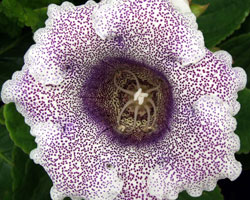
Gloxinias are lovely houseplants with large leaves and colorful flowers. Their velvety, bell-shaped flowers can average over three inches in diameter. Each flower is displayed on a long stem, or petiole. Their color-range is white to pink to red to blue to purple. They can also be two-toned with white centers or white rims. There are single and double flowering types, with petal edges smooth or wavy. Their foliage is oblong, graceful and velvety like their flowers.
Gloxinia can be started from seeds, tubers, or leaf or stem cuttings. Tubers are available for late winter and spring plantings and will flower about four months after planting. Producing flowering plants from seeds takes about six months. Plants grown from seeds have shorter internodes (the area of a stem between points of leaf attachment). As a result, they are more compact.
Gloxinia are usually started from tubers. Plant your tubers in the late winter, placing the tubers round-end down in moist peat moss. Space the tubers three to four inches apart with the top of the tubers one half inch or less below the surface. Allow indirect sunlight during this time, and keep the temperature about 70°F. Water sparingly until new growth appears because tubers rot easily. Once leaves emerge, fertilize your gloxinia with a liquid fertilizer, and follow the manufacturer’s recommendations. In four or five weeks, there should be enough new growth to shift the tubers into five or six-inch pots.
To grow gloxinias from leaf cuttings, select a partially mature leaf and insert it in a well-draining material such as mason’s sand, vermiculite, perlite, or a 50-50 mixture of mason’s sand and peat moss, or by just sticking a leaf in water. Keep the media moist but never soggy. Once the tuber forms, plant your gloxinia in a container.
Gloxinias grow best in a soil mixture of 50-percent organic matter, such as peat moss, which is available at most garden centers and nurseries. Most commercial potting soils are satisfactory, but if you prefer, you can blend your own using one part peat moss, one part compost, and one part perlite or vermiculite.
Gloxinias grow best near a south or west window during the winter. Insufficient light causes the stems to become long and spindly. Don’t allow leaves to touch the glass, because it may result in freeze damage. Protect plants from direct sunlight after May 1.
Gloxinia plants require a short rest in the fall. As soon as the leaves begin to die, gradually withhold water. Allow the tubers to rest two to four months in dry soil. Keep an eye on the plant and when new growth appears, resume watering. Then bring your gloxinia back into a sunny part of the house to begin a new growth cycle.
For “Commonly used plant terms” refer to message number 2008.



